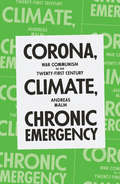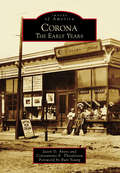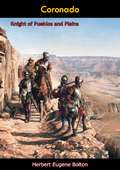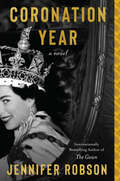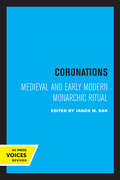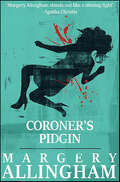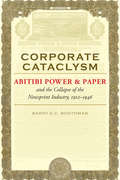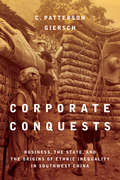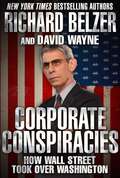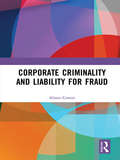- Table View
- List View
Corona de sangre
by José Luis CorralPara algunos, Pedro I fue siempre «el Cruel», para otros «el Justiciero». Solo la historia pudo juzgarlo. Solo esta novela puede retratarlo. Tras Matar al rey, José Luis Corral cierra la bilogía sobre el siglo más sangriento de España. 1350. Todos los grandes reinados empiezan con una corona ensangrentada. Cuando Alfonso XI, Rey de Castilla y León, muere a causa de la peste negra durante el asedio a Gibraltar, el reino queda huérfano, con las fronteras amenazadas y las cosechas devastadas. Será entonces cuando su hijo Pedro, un joven de quince años con gran sed de poder, que ha vivido apartado y marginado de la corte, se coronará rey. Empujado por las ansias de venganza de su madre, María de Portugal, y amenazado por la vil mirada de su hermano bastardo, Enrique de Trastámara, Pedro I provocará una oleada de violencia, odio ymasacres que determinarían el destino de los reinos de Castilla y León, Portugal y Granada y de la Corona de Aragón. Su reinado continuaría las traiciones, las alianzas y las guerras, desatadas por la envidia, amores prohibidos, sexo e intereses ocultos que traspasaron los muros de palacio y marcaron para siempre esta época como una de las más sangrientas de nuestra Historia. Corona de sangre es la segunda entrega de la bilogía que comenzó con Matar al rey. Ambas novelas narran los sucesos acontecidos en el siglo XIV, el más cruel y violento de la historia de España, y que culmina con su último -y más controvertido- rey: Pedro I de Castilla.
Corona, Climate, Chronic Emergency: War Communism in the Twenty-First Century
by Andreas MalmWhat does the COVID 19 tell us about the climate breakdown, and what should we do about it?The economic and social impact of the coronavirus pandemic has been unprecedented. Governments have spoken of being at war and find themselves forced to seek new powers in order to maintain social order and prevent the spread of the virus. This is often exercised with the notion that we will return to normal as soon as we can. What if that is not possible? Secondly, if the state can mobilize itself in the face of an invisible foe like this pandemic, it should also be able to confront visible dangers such as climate destruction with equal force. In Corona, Climate, Chronic Emergency, leading environmental thinker, Andreas Malm demands that this war-footing state should be applied on a permanent basis to the ongoing climate front line. He offers proposals on how the climate movement should use this present emergency to make that case. There can be no excuse for inaction any longer.
Corona: The Early Years (Images of America)
by Jason D. Antos Burt Young Constantine E. TheodosiouNestled between old Newtown (today's Elmhurst) and the village of Flushing in the borough of Queens lies Corona. Blessed with an enchanting landscape, the area attracted development as early as 1854, when the West Flushing Land Company sought to create a suburban residential neighborhood in its midst. For Corona's cherished way of life, represented by Colonial-era farms, dirt roads, and gaslight streetlamps, this marked a distinct break from the past. Developer Benjamin Hitchcock's novel installment-plan system had helped place Corona on the map for good by 1870, laying down a historical precedent for later communities like Forest Hills and Jackson Heights to take shape. Before Mets baseball and the US Open were fixtures on the local scene, New Yorkers flocked to the National Race Course, one of the first such complexes in the entire country, for an exciting day at the races. Meanwhile, in its Corona-based factory, the Tiffany Glass Company forged distinctive lamps and glassware that in time would become world famous.
Coronado's Children: Tales of Lost Mines and Buried Treasures of the Southwest (Barker Texas History Center Series)
by J. Frank Dobie&“This is the best work ever written on hidden treasure, and one of the most fascinating books on any subject to come out of Texas.&” —Basic Texas Books Written in 1930, Coronado&’s Children was one of J. Frank Dobie&’s first books, and the one that helped gain him national prominence as a folklorist. In it, he recounts the tales and legends of those hardy souls who searched for buried treasure in the Southwest following in the footsteps of that earlier gold seeker, the Spaniard Coronado. &“These people,&” Dobie writes in his introduction, &“no matter what language they speak, are truly Coronado&’s inheritors . . . I have called them Coronado&’s children. They follow Spanish trails, buffalo trails, cow trails, they dig where there are no trails; but oftener than they dig or prospect they just sit and tell stories of lost mines, of buried bullion by the jack load . . .&” This is the tale-spinning Dobie at his best, dealing with subjects as irresistible as ghost stories and haunted houses. &“As entrancing a volume as one is likely to pick up in a month of Sundays.&” —The New York Times &“Dobie has discovered for us a native Arabian Night.&” —Chicago Evening Post
Coronado's Children: Tales of Lost Mines and Buried Treasures of the Southwest (Barker Texas History Center Series)
by J. Frank DobieWritten in 1930, Coronado's Children was one of J. Frank Dobie's first books, and the one that helped gain him national prominence as a folklorist. In it, he recounts the tales and legends of those hardy souls who searched for buried treasure in the Southwest following in the footsteps of that earlier gold seeker, the Spaniard Coronado. "These people," Dobie writes in his introduction, "no matter what language they speak, are truly Coronado's inheritors. . . . l have called them Coronado's children. They follow Spanish trails, buffalo trails, cow trails, they dig where there are no trails; but oftener than they dig or prospect they just sit and tell stories of lost mines, of buried bullion by the jack load. . . " This is the tale-spinning Dobie at his best, dealing with subjects as irresistible as ghost stories and haunted houses.
Coronado: Knight of Pueblos and Plains
by Herbert E. BoltonHerbert Eugene Bolton&’s classic of southwestern history, first published in 1949, delivers the epic account of Francisco Vásquez de Coronado&’s sixteenth-century entrada to the North American frontier of the Spanish Empire. Leaving Mexico City in 1540 with some three hundred Spaniards and a large body of Indian allies, Coronado and his men—the first Europeans to explore what are now Arizona and New Mexico—continued on to the buffalo-covered plains of Texas and into Oklahoma and Kansas. With documents in hand, Bolton personally followed the path of the Coronado expedition, providing readers with unsurpassed storytelling and meticulous research.
Coronado: Knight of Pueblos and Plains
by Herbert Eugene BoltonHerbert Eugene Bolton, who was well-known for his books on the Southwest and Spanish Americas, here recounts in detail Francisco Vasquez de Coronado’s sixteenth-century entrada to the North American frontier of the Spanish Empire.In retracing Coronado’s route, Professor Bolton—with access to new information—was able to relive the experiences of the original exploration. Originally published in 1949, he brings fresh insight and profound knowledge to CORONADO: Knight of Pueblos and Plains.“Thoroughly documented, this tells of the search for El Dorado, the preliminary explorations of Fray Marcos seeking the Seven Cities of Cibola, Alarcon’s voyage, the discovery of the Colorado, the explorations of Coronado and his lieutenants…Then there are Coronado’s later years as governor of Nueva Galicia, his trial and acquittal.”—Kirkus Review
Coronation
by Paul GallicoThe wheels of the Coronation Special from Sheffield, due at St. Pancras Station at six o'clock in the morning of Coronation Day, sang the steady, lulling dickety-clax, dickety-clax of the British Railways. Approaching a crossing, the engine shrieked hysterically into the drizzly night as it pulled its heavy load through the countryside, London bound. In the third-class compartment occupied by the five members of the Clagg family and three other passengers, no one slept, though Granny kept nagging at the two children to try to do so because of the long exciting day ahead.
Coronation Year: A Novel
by Jennifer RobsonThe USA Today bestselling author of The Gown returns with another enthralling and royal historical novel— as the lives of three very different residents of London’s historic Blue Lion hotel converge in a potentially explosive climax on the day of Queen Elizabeth’s Coronation.It is Coronation Year, 1953, and a new queen is about to be crowned. The people of London are in a mood to celebrate, none more so than the residents of the Blue Lion hotel.Edie Howard, owner and operator of the floundering Blue Lion, has found the miracle she needs: on Coronation Day, Queen Elizabeth in her gold coach will pass by the hotel’s front door, allowing Edie to charge a fortune for rooms and, barring disaster, save her beloved home from financial ruin. Edie’s luck might just be turning, all thanks to a young queen about her own age. Stella Donati, a young Italian photographer and Holocaust survivor, has come to live at the Blue Lion while she takes up a coveted position at Picture Weekly magazine. London in celebration mode feels like a different world to her. As she learns the ins and outs of her new profession, Stella discovers a purpose and direction that honor her past and bring hope for her future.James Geddes, a war hero and gifted artist, has struggled to make his mark in a world that disdains his Indian ancestry. At the Blue Lion, though, he is made to feel welcome and worthy. Yet even as his friendship with Edie deepens, he begins to suspect that something is badly amiss at his new home.When anonymous threats focused on Coronation Day, the Blue Lion, and even the queen herself disrupt their mood of happy optimism, Edie and her friends must race to uncover the truth, save their home, and expose those who seek to erase the joy and promise of Coronation Year.
Coronation Year: An enthralling historical novel, perfect for fans of The Crown
by Jennifer RobsonThe author of The Gown returns with another enthralling and royal-adjacent historical novel - as the lives of three very different residents of London's historic Blue Lion hotel converge in a potentially explosive climax on the day of Queen Elizabeth's Coronation. Perfect for fans of The Crown..............................London, 1953. A new Queen is about to be crowned, and at the historic Blue Lion Hotel, the lives of three residents are about to change in unexpected ways. Edie Howard, owner of the hotel, needs a miracle to rescue it from closure. Now, it will become a sought after spot as the young Queen's carriage passes by on Coronation Day, offering Edie the chance to save her business from financial ruin. Stella Donati, an Italian photographer and Holocaust survivor, lives at the Blue Lion. Her coveted position at Picture Weekly magazine opens a different world, giving her a purpose she thought she had lost with everything else she knew. James Geddes, a gifted artist, has struggled to make his mark since his return from active service in the war in a world that disdains his Indian heritage. The Blue Lion affords him sanctuary and a welcome. Yet as his friendship with Edie deepens, he begins to suspect that something is badly amiss.When anonymous threats focus on Coronation Day, Edie, Stella and James are determined to save their home, their livelihoods, and to expose those who seek to destroy them and the joyful promise of Coronation Year..............................Don't miss The Gown - an enthralling historical novel about one of the most famous wedding dresses of the twentieth century - Queen Elizabeth's wedding gown - and the fascinating women who made it:'Will dazzle and delight' Independent'Robson succeeds in creating a riveting drama of female friendship, of lives fully lived despite unbearable loss, and of the steadfast effort required to bring forth beauty after surviving war' Independent'A great tale of female friendship' People's Friend
Coronations: Medieval and Early Modern Monarchic Ritual
by János M. BakFascination with royal pomp and circumstance is as old as kingship itself. The authors of Coronations examine royal ceremonies from the ninth to the sixteenth century, and find the very essence of the monarchical state in its public presentation of itself. This book is an enlightened response to the revived interest in political history, written from a perspective that cultural historians will also enjoy. The symbolic and ritual acts that served to represent and legitimate monarchical power in medieval and early modern Europe include not only royal and papal coronations but also festive entries, inaugural feasts, and rulers' funerals. Fifteen leading scholars from North America, Britain, France, Germany, Poland, and Denmark explore the forms and the underlying meanings of such events, as well as problems of relevant scholarship on these subjects. All the contributions demonstrate the importance of in-depth study of rulership for the understanding of premodern power structures. Emphasis is placed on interdisciplinary approaches, drawing on the findings of ethnography and anthropology, combined with rigorous critical evaluation of the written and iconic evidence. The editor's historiographical introduction surveys the past and present of this field of study and proposes some new lines of inquiry. "For 'reality' is not a one-dimensional matter: even if we can establish what actually transpired, we still need to ask how it was perceived by those present." This title is part of UC Press's Voices Revived program, which commemorates University of California Press's mission to seek out and cultivate the brightest minds and give them voice, reach, and impact. Drawing on a backlist dating to 1893, Voices Revived makes high-quality, peer-reviewed scholarship accessible once again using print-on-demand technology. This title was originally published in 1990.
Coronel and Falklands 1914
by Peter Dennis Michael McnallyAdmiral von Spee's German East Asia Cruiser Squadron of World War I stand out amidst the annals of 20th century surface naval warfare. Upon the outbreak of war in August 1914, the British Royal Navy was deployed globally, whilst aside from a small number of local vessels, the Imperial German Navy was concentrated in two areas - Home Waters (i.e. the North Sea and the Baltic) and Tsingtao in China, the home port of the crack East Asia Cruiser Squadron which, under the command of Admiral Reichsgraf von Spee contained some of Germany's most modern cruisers. As it was clear that Spee's relatively small force would be quickly overwhelmed by superior enemy numbers, the Admiralty in Berlin immediately ordered him to weigh anchor and return to Germany, a mission that many were to describe as a Himmelfahrtskommando or suicide mission. Whether Spee made it or not, the main consideration was that he would tie down a large number of enemy warships and thus prevent their deployment in other areas. This Raid title details all aspects of the exciting mission.From the Trade Paperback edition.
Coronel and the Falklands
by Capt. Geoffrey BennettOn 1 November 1914, off the coast of Chile near Coronel, ships of the German and British navies exchanged fire, resulting in the sinking of two British ships HMS Monmouth and HMS Good Hope with the loss of nearly 1,600 sailors. To counter the German squadron, the Royal Navy sent two battle-cruisers—Inflexible and Invincible—to the South Atlantic. In December 1914, the British battle-cruisers, accompanied by smaller ships, engaged the German squadron during the Battle of the Falkland Islands and sank the German armoured cruisers SMS Scharnhorst and SMS Gneisenau near the Falkland Islands.First published in 1962, this is a gripping account of the World War I British-German naval battles off the coast of South America, and an examination of the issue of Britain’s preparation for naval warfare in 1914.
Coroner Creek (Center Point Western Enhanced (large Print) Ser.)
by Luke ShortA gunfighter rides high and low on a manhunt for the Apache who killed his fiancée in this blazing story of revenge from a master storyteller of the West. The army wagon train carried rifles, ammunition, and a chestful of gold through Apache territory, where every white man was a target. With the soldiers rode a single stagecoach carrying the woman whom Chris Danning planned to marry. When the train passed through Karnes Canyon, an Apache raiding party stormed out of the shadows, and the creek ran red with blood. For eighteen months now, Danning has searched for the Apache who attacked the wagon train and killed his fiancée. He&’s also hunting the corrupt white man who sold the soldiers out. With the help of a grizzled Indian scout, Danning finally gets the name of the Apache chief and a description of their informer. When he finds them, the real battle will begin. A truly unique saga of vengeance and obsession in the American West, Coroner Creek—which was made into a 1948 Columbia Pictures film starring Randolph Scott—explores the darkest parts of the cowboy soul. .
Coroner at Large
by Thomas T. Noguchi Joseph DimonaNoguchi, once Chief Medical Examiner for Los Angeles, is fascinated by forensic evidence in crimes. He applies forensic principles to many recent cases plus historical ones.
Coroner's Pidgin (The Albert Campion Mysteries)
by Margery Allingham“Allingham has that rare gift in a novelist, the creation of characters so rich and so real that they stay with the reader forever.” —Sara ParetskyWorld War II is limping to a close and private detective Albert Campion has just returned from years abroad on a secret mission. Relaxing in his bath before rushing back to the country, and to the arms of his wife, Amanda, Campion is disturbed when his servant, Lugg, and a lady of unmistakably aristocratic bearing appear in his flat carrying the corpse of a woman.The reluctant Campion is forced to put his powers of detection to work as he is drawn deeper into the case, and into the eccentric Caradocs household, dealing with murder, treason, grand larceny, and the mysterious disappearance of some very valuable art. “Margery Allingham deserves to be rediscovered.” —P.D. James“Margery Allingham was one of the greatest mid-20th-century practitioners of the detective novel.” —Alexander McCall Smith
Corporal Hitler and the Great War 1914-1918: The List Regiment (Cass Military Studies)
by John F WilliamsAdolf Hitler enlisted in the Bavarian Army in august 1914 as a war volunteer. Fanatically devoted to the German cause, between 1914 and 1918 Hitler served with distinction and sometimes reckless bravery, winning both classes of Iron Cross. Using memoirs, military records, regimental, divisional and official war histories as well as (wherever possible) Hitler's own words, this book seeks to reconstruct a period in his life that has been neglected in the literature. It is also the story of a German regiment (16th Bavarian Reserve Infantry, or List Regiment), which fought in all the main battles on the Western Front. As a frontline soldier Hitler began his 'study' of the black art of propaganda; and, as he himself maintained, the List Regiment provided him with his 'university of life'. This is not only an account of the fighting, however. Some of the most profound influences on Hitler occurred on home leave or as a result of official wartime propaganda, which he devoured uncritically. His conversion from passive pathological anti-Semitism began while invalided in Germany in 1916-17. The language of anti-Bolshevik 'Jewish virus' propaganda became Hitler's language, confirmed, as he saw it, by the 'infected' recruits to the List Regiment in 1918.Hitler is here presented less as the product of high-cultural forces than as an avid reader and gullible consumer of state propaganda, which fed his prejudices. He was a 'good soldier' but also a 'true believer' in fact and practice. It is no exaggeration to say that every military decision made by Hitler between 1939 and 1945 was in some way influenced or coloured by his experiences with the List Regiment between 1914 and 1918.
Corporate Capitalism and the Integral State: General Electric and a Century of American Power (Marx, Engels, and Marxisms)
by Stephen MaherThis book advances an original conception of the relationship between state and corporate power in the United States. Using what he terms an Institutional Marxist framework, Maher argues that, far from passively responding to interest group pressures, the state has been a key agent in politically mobilizing business, and has played an active role in the organization of lobbying groups. Such business associations do not merely express the pre-existing interests of their corporate members, but are also mechanisms through which the state organizes the political power of the capitalist class. They form part of what the author refers to as an integral state—a wider network of state power which traverses and interpenetrates the state bureaucracy, the legislature, the industrial policy apparatus, and corporate governance. Based on extensive archival research, this book tracks the role of the General Electric Company as a pillar of the integral state in the United States from the finance capital period (1880 to 1930), through the managerial period (1930-1979), to the restructuring leading up to the age of neoliberalism (1979-present).
Corporate Cataclysm: Abitibi Power & Paper and the Collapse of the Newsprint Industry, 1912–1946 (Themes in Business and Society)
by Barry E.C. BoothmanIn this absorbing narrative, Barry E.C. Boothman traces the history of Abitibi Power and Paper Limited alongside the rise and fall of the newsprint industry and the advent of Canadian corporate capitalism. In the first half of the twentieth century, Abitibi was Canada’s biggest manufacturer – an apparent success story after the Wall Street crash of 1929 and a company deemed "too big to fail" – but the company eventually ended up at the centre of the longest and most controversial bankruptcy in Canadian history. Moving from the frontier areas of northern Ontario to the heart of the continental economy, Corporate Cataclysm shows how competitive strategies, industrial organization, corporate finance, and law combined with the empire-building dreams of entrepreneurs and the concerns of politicians to generate an economic disaster. It then chronicles the disputes and intense strife that plagued Abitibi’s fourteen-year receivership.
Corporate Catalyst
by Tony GriffithsAn inside look at the real business worldIn Corporate Catalyst, Tony Griffiths gives readers a ringside seat on the many boardroom and corporate battles that he both fought and witnessed through the nearly six decades of his productive and colorful career. Among other stories, Griffiths replays his two stints as the CEO of Canada's darling of the telecom industry, Mitel Corporation. The first was in the late 1980s, a time when he helped staunch the flow of red ink and returned the company to profitability. The second was in the early 1990s, when he steered the company through its majority ownership by British Telecom and then its sale to Schroder Ventures. As Griffiths relates it, he had to learn how to deal with the bureaucratic style of the former and the power-hungry moves of the latter.Corporate Catalyst includes the author's blow-by-blow account of what went on inside Confederation Life in the 1980s and early 1990s--a story that should have prevented the failure of the likes of Lehman Brothers in the recent Great Recession. Griffiths, who had his hands full at the time with challenges at Mitel, also sat on Confed's board. He tried to warn Confederation Life's executives and his fellow board members of the financial dangers the company was facing. No one but a few other board members would listen-and even they did not do so consistently. The fall of Confed Life became one of the largest failures of a major finance company in corporate history.Griffiths takes the reader on a dramatic tour of the trickery, betrayal, and politicking that the world of business seems to attract. He introduces readers to the biggest and boldest names in Canadian business, including Jake Moore of Brascan, Robert Campeau of Campeau Corporation, Terry Mathews of Mitel, Ted Rogers of Rogers Communications, Conrad Black of Hollinger, Adam Zimmerman of Noranda, Pat Burns of Confederation Life, and Christopher Ondaatje of The Ondaatje Corporation.In the book's many cautionary tales, Griffiths warns against mixing the roles of governance and management and shows the marked tendency of executives to take up residence far from reality when times get tough. "We don't listen. We don't plan. We don't act," he wrote in frustration to the board and management of Confederation Life after months of trying to get someone to address the financial mess they were in.Full of hard-won wisdom, Corporate Catalyst is a must-read for anyone working in business or interested in what the business world is really like.
Corporate Character
by Eddy KentThe vastness of Britain's nineteenth-century empire and the gap between imperial policy and colonial practice demanded an institutional culture that encouraged British administrators to identify the interests of imperial service as their own. In Corporate Character, Eddy Kent examines novels, short stories, poems, essays, memoirs, private correspondence, and parliamentary speeches related to the East India Company and its effective successor, the Indian Civil Service, to explain the origins of this imperial ethos of "virtuous service."Exploring the appointment, training, and management of Britain's overseas agents alongside the writing of public intellectuals such as Edmund Burke, Thomas Malthus, Thomas Babington Macaulay, and J.S. Mill, Kent explains the origins of the discourse of "virtuous empire" as an example of corporate culture and explores its culmination in Anglo-Indian literature like Rudyard Kipling's Kim. Challenging narratives of British imperialism that focus exclusively on race or nation, Kent's book is the first to study how corporate ways of thinking and feeling influenced British imperial life.
Corporate Conquests: Business, the State, and the Origins of Ethnic Inequality in Southwest China
by C. Patterson GierschTenacious patterns of ethnic and economic inequality persist in the rural, largely minority regions of China's north- and southwest. Such inequality is commonly attributed to geography, access to resources, and recent political developments. In Corporate Conquests, C. Patterson Giersch provides a desperately-needed challenge to these conventional understandings by tracing the disempowerment of minority communities to the very beginnings of China's modern development. Focusing on the emergence of private and state corporations in Yunnan Province during the late 1800s and early 1900s, the book reveals how entrepreneurs centralized corporate power even as they expanded their businesses throughout the Southwest and into Tibet, Southeast Asia, and eastern China. Bringing wealth and cosmopolitan lifestyles to their hometowns, the merchant-owners also gained greater access to commodities at the expense of the Southwest's many indigenous minority communities. Meanwhile, new concepts of development shaped the creation of state-run corporations, which further concentrated resources in the hands of outsiders. The book reveals how important new ideas and structures of power, now central to the Communist Party's repertoire of rule and oppression, were forged, not along China's east coast, but along the nation's internal borderlands. It is a must-read for anyone wishing to learn about China's unique state capitalism and its contribution to inequality.
Corporate Conservatives Go to War: How the National Association of Manufacturers Planned to Restore American Free Enterprise, 1939–1948 (Palgrave Studies in American Economic History)
by Charlie WhithamWorld War II presented a unique opportunity for American business to improve its reputation after years of censure for inflicting the Great Depression upon the nation. No employers’ organization worked harder or devoted greater resources to reviving business prestige during the war than the National Association of Manufacturers, which spent millions of dollars on promoting the indispensability of private enterprise to the successful mobilization of the American economy in an uncompromising multi-media campaign which spanned the factory floor to the movie theatre. Now, using unpublished primary sources, the full extent of the NAM’s wartime mission to raise the stature of American business in the post-war era is revealed. During the war the NAM erected a vast structure of research on an unprecedented scale numbering more than one hundred persons dedicated to planning the best solutions for restoring American ‘free enterprise’ capitalism after the war in a direct challenge to the ‘liberal’ prescriptions of the reigning administration. These studies were painstakingly assembled and widely distributed and served as a complimentary arm to the better-known pro-business propaganda message of the organization. What emerges is a unique and telling glimpse into the minds of the corporate class of wartime America that reveals the determination of a major employers’ organization to exploit the exceptional circumstances of total war to influence both the power-brokers in Washington who wrote economic policy and the American public as a whole to embrace a post-war future ruled by private enterprise capitalism.
Corporate Conspiracies: How Wall Street Took Over Washington
by Richard Belzer David WayneFrom New York Times bestselling authors Richard Belzer and David Wayne comes a hard look at the wrongs done to us all by big business in America. Here is an explosive account of wrongful acts perpetrated, and the ensuing cover-ups inflicted upon us, by American corporations. The bestselling author team of Richard Belzer and David Wayne exposes the ways that the capitalist regime has got us under their thumbs—from the mainstream media and its control over us, to the trillions stolen by big banks and mortgage companies during the mortgage crisis, to the scams perpetrated by Big Oil and Big Pharma. The one common victim of all that corruption is the American public, and Corporate Conspiracies wants to do something about it.Corporate Conspiracies takes dead aim at those who take advantage of us little guys. Probably most disturbing is the book's examination of politics and capitalism teaming up against us—how politicians and lobbyists all have their hands in each other's pockets while stabbing us in the back, and how the well-established energy lobby—which is petroleum, natural gas, and coal—has played a dominant role in the shaping of US foreign policy for decades. Did you know that companies at times know that their products will kill people, but they do nothing, because it is actually cheaper to compensate the victims than it is to correct the problem? And did you know that the Pentagon is sending $1.5 trillion of our tax dollars to their corporate buddies for a new fighter jet that is already superfluous? This book is guaranteed to make us all think twice about being enslaved and cheated by corporate America. Skyhorse Publishing, as well as our Arcade imprint, are proud to publish a broad range of books for readers interested in history—books about World War II, the Third Reich, Hitler and his henchmen, the JFK assassination, conspiracies, the American Civil War, the American Revolution, gladiators, Vikings, ancient Rome, medieval times, the old West, and much more. While not every title we publish becomes a New York Times–bestseller or a national bestseller, we are committed to books on subjects that are sometimes overlooked and to authors whose work might not otherwise find a home.
Corporate Criminality and Liability for Fraud
by Alison CroninThrough a rational reconstruction of orthodox legal principles, and reference to cutting-edge neuro-science, this book reveals some startling truths about the criminal law, its history and the fundamental doctrines that underpin the attribution of criminal fault. While this has important implications for the criminal law generally, the focus of this work is the development of a theory of corporate criminality that accords with modern theory of group agency, itself informed by advancements in contemporary philosophy and social science. The innovation it proposes is the theoretical and practical means by which criminal fault can be attributed directly to the corporate actor, where liability cannot or should not be reduced to its individual members.

